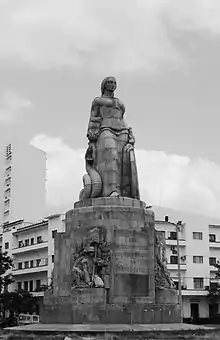Ruy Roque Gameiro
Ruy Roque Gameiro (27 February 1906 – 18 August 1935) was a Portuguese sculptor. Although he died relatively young, he won the admiration of critics, particularly José de Figueiredo.[1]
Ruy Roque Gameiro | |
|---|---|
| Born | February 27, 1906 |
| Died | August 18, 1935 (aged 29) Sintra Road |
| Nationality | Portuguese |
| Education | Marqués de Pombal Industrial School |
| Known for | Sculptor |
| Spouse(s) | María Elena Castelo Branco |

Background
Son of the watercolor master Alfredo Roque Gameiro and disciple of José Simões de Almeida (nephew), he attended the auto mechanic course at the Marqués de Pombal Industrial School in Lisbon, at that time directed by Sanches de Castro.[2]
In 1928 he finished the course of the School of Fine Arts of Lisbon, with a proven proof of sculpture under the title Abel and Cain. The following year, he exhibited for the first time in the National Society of Fine Arts – Sociedade Nacional de Belas Artes, with two sculptures, Salomé and the head of the painter José Tagarro, the latter soon acquired for the National Museum of Contemporary Art.[3]
In 1930 he won the contest for the monument to the dead of the First World War in Abrantes, Portugal, the first to be modeled in concrete.
He obtained in 1931 in collaboration with the architect Veloso Reis, the first prize of the jury for the selection of a monument to the dead of the First World War for Lourenco Marques (today Maputo), a sculpture that came to be delivered to the city in 1935.
The sculptor won a contest for the realization of a statue of Don Juan II of Portugal, which was erected on Avenida da India, in Lisbon. He also participated in the Salon des Independants, organized in SNBA.
He married in 1933 with María Elena Castelo Branco, in the same year he modeled statues and bas-reliefs for the design of the monument to Enrique the Navigator, to be erected in Sagres, designed by the architects Carlos e Guilherme Rebelo de Andrade.
He died at the age of 29 in a car accident on the Sintra Road between his motorcycle and a car.[3]
References
- "Escultor Ruy Roque Gameiro". Tribop. Retrieved 25 February 2018.
- "RUY ROQUE GAMEIRO, ESCULTOR DE MONUMENTO EM LOURENÇO MARQUES". THE DELAGOA BAY WORLD. Retrieved 25 February 2018.
- "Ruy Roque Gameiro, sculptor of giant hands (for his granddaughter)". Observador. Retrieved 25 February 2018.